Intro 科研团队
Team 主要研究
Research 学术交流
Activities 科研项目
Funding 科研成果
Outputs 人才培养
Students 加入我们
Join us
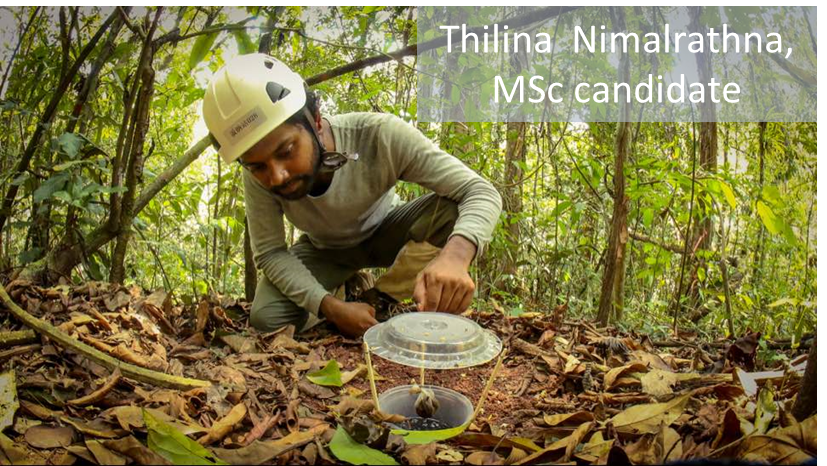
(i) A review article (Trends in Ecology and Evolution, IF 2018=15.236, Top10) published in June 2017
Nakamura is the lead author of a review paper published in Trends in Ecology and Evolution (Nakamura et al. 2017) where, with his Chinese and international co-authors, they documented recent progress in canopy ecology and presented future research directions such as vertical stratification of biodiversity and trophic interactions, which are currently main focus of our groups and being investigated through several projects led by our groups members. This review also emphasized the research opportunities provided by canopy cranes which are increasing in number worldwide, but particularly in China where a total of eight canopy cranes have been built so far (Figure 1).
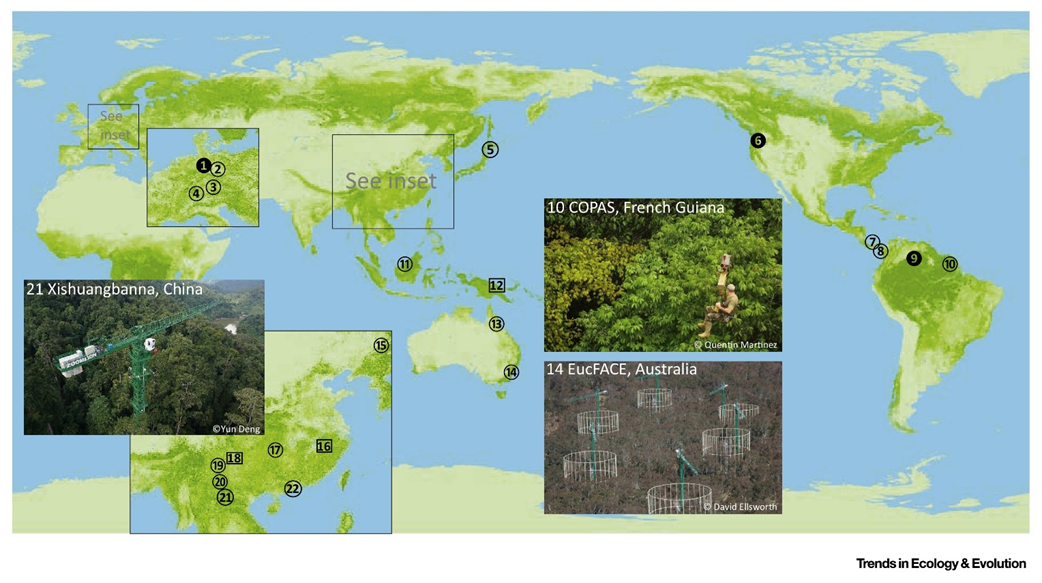
Figure 1. A map (Nakamura et al. 2017) showing the locations of canopy cranes and other canopy access facilities. Open circles are locations of canopy cranes established or currently being built, closed-circles are disused or dismantled canopy cranes, and squares are planned cranes (as of February 2020, all of the planned cranes in China and PNG have been established.
(ii) “Quantifying the factors affecting wood decomposition across a tropical forest disturbance gradient” published in Forest Ecology and Management in 2020 (IF 2018=3.126, Top10)
Dossa et al. studied the impacts of anthropogenic disturbance on ecosystem functioning. They used wood specific gravity-WSG loss and mass loss to study wood decomposition along tropical forest disturbance gradient. The results showed that core position relative to soil interact with bark thickness to influence WSG loss. Higher initial wood N content and thicker bark lead to higher WSG loss for up core. Open habitats show higher termite infestation and higher mass loss than forests (Figure 2). WSG loss is not a good predictor of mass loss especially in the presence of termites.
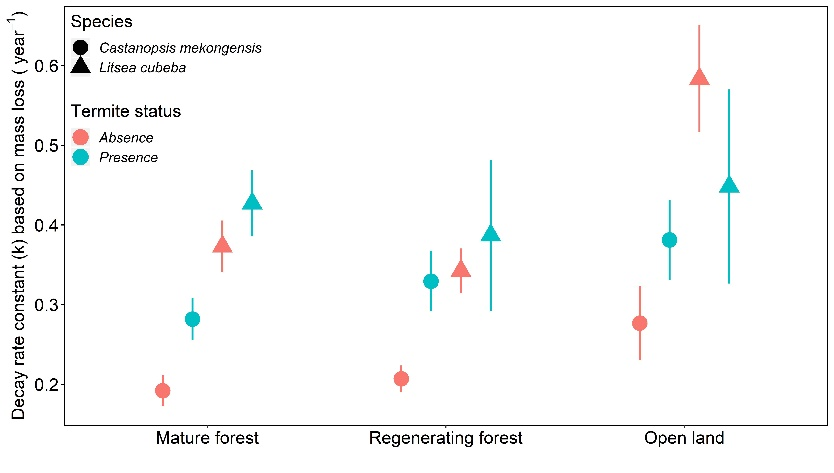
Figure 2. Decay rate constant (k) for logs installed across 28 plots in the Mengsong landscape as measured after 36 mo incubation. The k values were calculated on a mass loss basis. Points represent mean k value for logs for two species (triangle symbols for Litsea cubeba and circle symbols for Castanopsis mekongensis) with respect to termite infestation status at end of the experiment (blue = presence; red = absence) within different disturbance gradient categories (mature forest, regenerating forest and open-land).
(iii) Global clay caterpillar project
Nakamura participated the global scale field experiment to quantify predation rate across latitude and elevation (Roslin et al. 2017, Science). “Risky in the tropics: It is well known that diversity increases toward the tropics. Whether this increase translates into differences in interaction rates among species, however, remains unclear. To simplify the problem, Roslin et al. tested for predation rates by using a single approach involving model caterpillars across six continents. Predator attack rates were higher toward the equator, but only for arthropod predators.” (Science: https://science.sciencemag.org/content/356/6339/742.full).
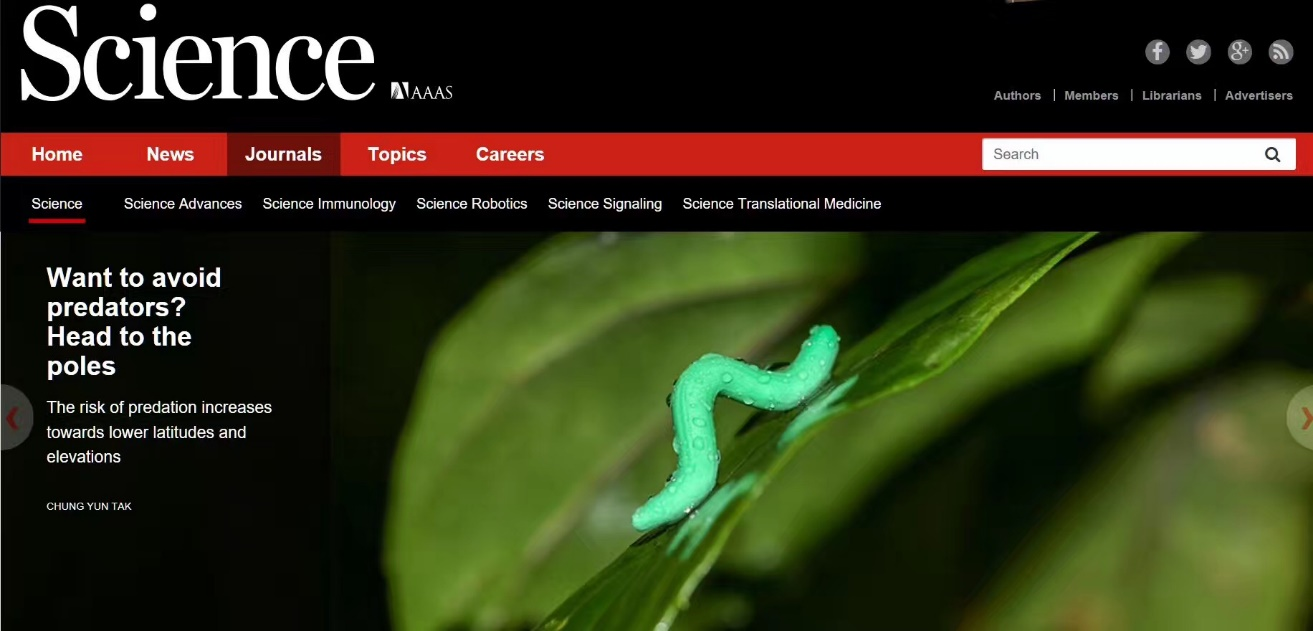
(iv) Are you a poop or…? Assessing seasonal change of predation rate on caterpillar visual traits and testing sawfly masquerading using artificial dummy caterpillars
Mizuno and Nakamura supervised one of the intern students from Puer College to conduct a research project to investigate the effectiveness of sawfly caterpillar colors and shapes on avoiding predation. We assessed temporal changes in the defensive value of masquerading , using six types of plasticine dummy caterpillars: three colors (green, black, and white) × two shapes (curled and straight). These dummy caterpillars were deployed five times over one year in tropical forests of Xishuangbanna, southwestern China, and, as a comparison, twice in a temperate forest of Hirosaki, Japan. We found that black and curled caterpillars received significantly lower predation by birds in Xishuangbanna, and this has remained constant over time, suggesting that the effectiveness of masquerading is robust through time for visual predators such as birds. We are currently working on the manuscript based on the results of this project.
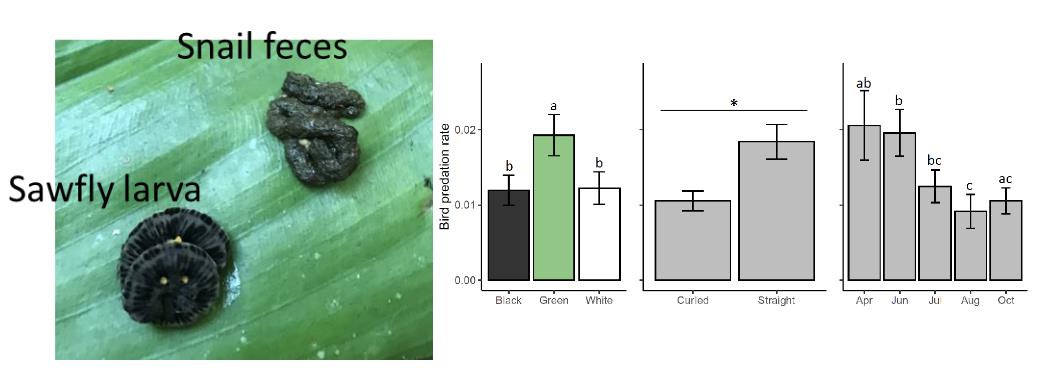
Similar? Or not…
(v) Collaborative work with the University of Hong Kong resulted in three papers published in Oecologia, Ecological Entomology and Biological Journal of Linnean Society
Through a long and solid collaboration with researchers from the Hong Kong University, Nakamura has unofficially supervised two PhD students. This collaboration has resulted in two publications with Nakamura as corresponding author and one with Nakamura as co-author in international journals in 2018. The first paper (Xing … Nakamura* et al. 2018 Oecologia) investigated how wing and body colours of moths change in response to differences in latitude, elevation and vertical stratum. The study found that even nocturnal insects, such as moths, become darker with increasing elevation, especially in the canopy of subalpine forests (Figure 3). This study suggests the important roles of body coloration for thermoregulation and UV protection of nocturnal insects.
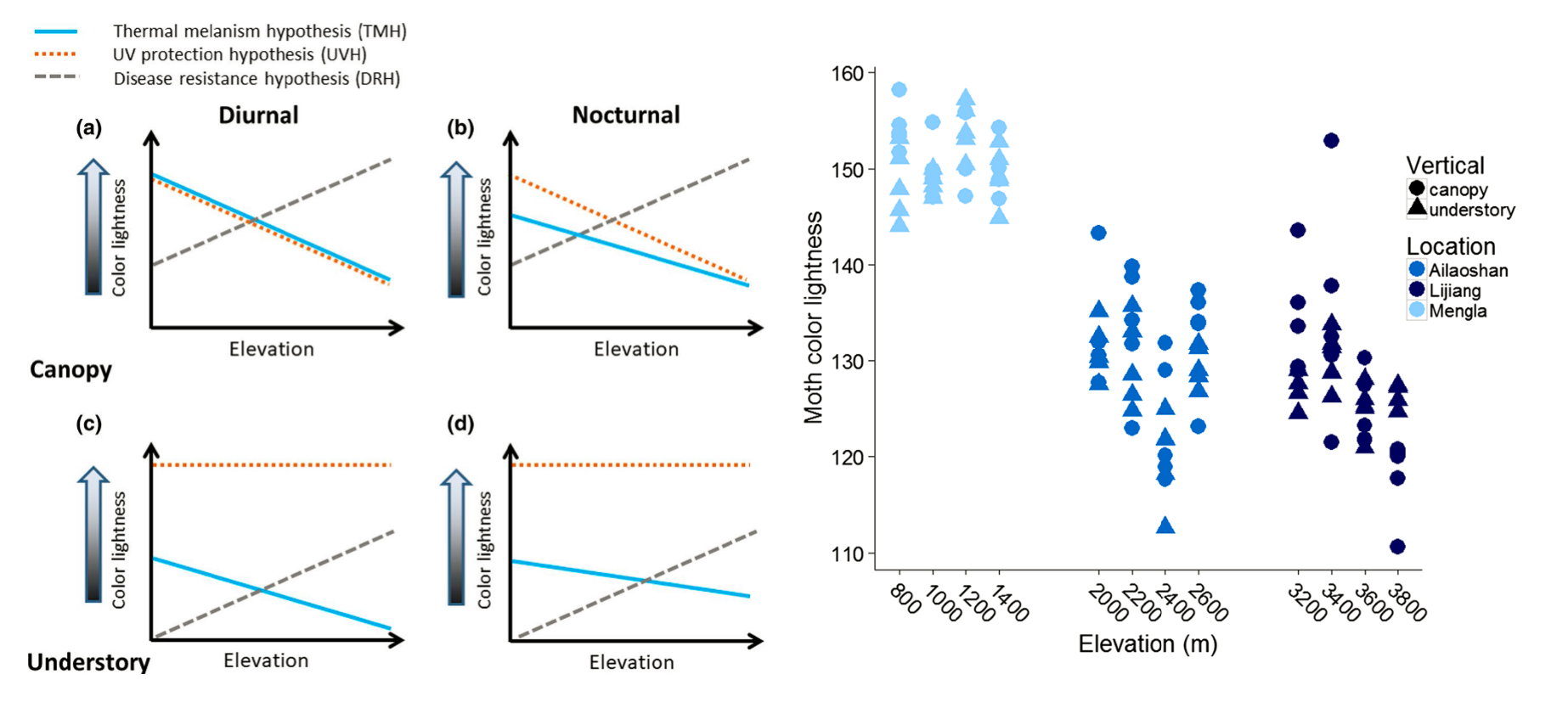
Figure 3. Hypothetical illustrations (left) of color lightness patterns across elevational gradients according to the three hypotheses (the TMH, UVH and DRH) comparing. diurnal (a, c) and nocturnal (b, d) insects within the forest canopy (a, b) and understory (c, d) strata. Mean color lightness of moth assemblages (right) in the canopy (circle) and understory (triangle) strata, along the elevational gradients of the three locations.
The second paper (Cheng … Nakamura* et al. 2018 Ecological Entomology) showed that butterflies in rainforest understorey assist not only thermoregulation but predation avoidance by being darker compared with the ones found in open areas. We first used field observations to show that butterflies were darker in the rainforest than open areas. Manipulative experiment then found that dark coloured artificial butterflies experienced significantly less predation than the light colored artificial butterflies in the rainforest understorey, whereas no differences in predation rate were found in open areas.
(vi) Insect diversity and body size variation along elevational gradients
Alyssa Fontanilla (MSc candidate, graduated in 2019) examined patterns of taxonomic and functional alpha and beta diversity and body size variation in insects across elevation using specimens sampled in 2011 and 2012 along three elevational transects in Yunnan Province: tropical Mengla, subtropical Ailaoshan and subalpine Lijiang. The results based on functional diversity showed higher taxonomic and functional ant diversity towards warmer climates, and the temperature in the higher elevations of the Ailaoshan is close to their thermal limits, causing the functional trait space to shrink at higher elevations (Figure 4). This work has been published in the international Q1 journal, Insects.
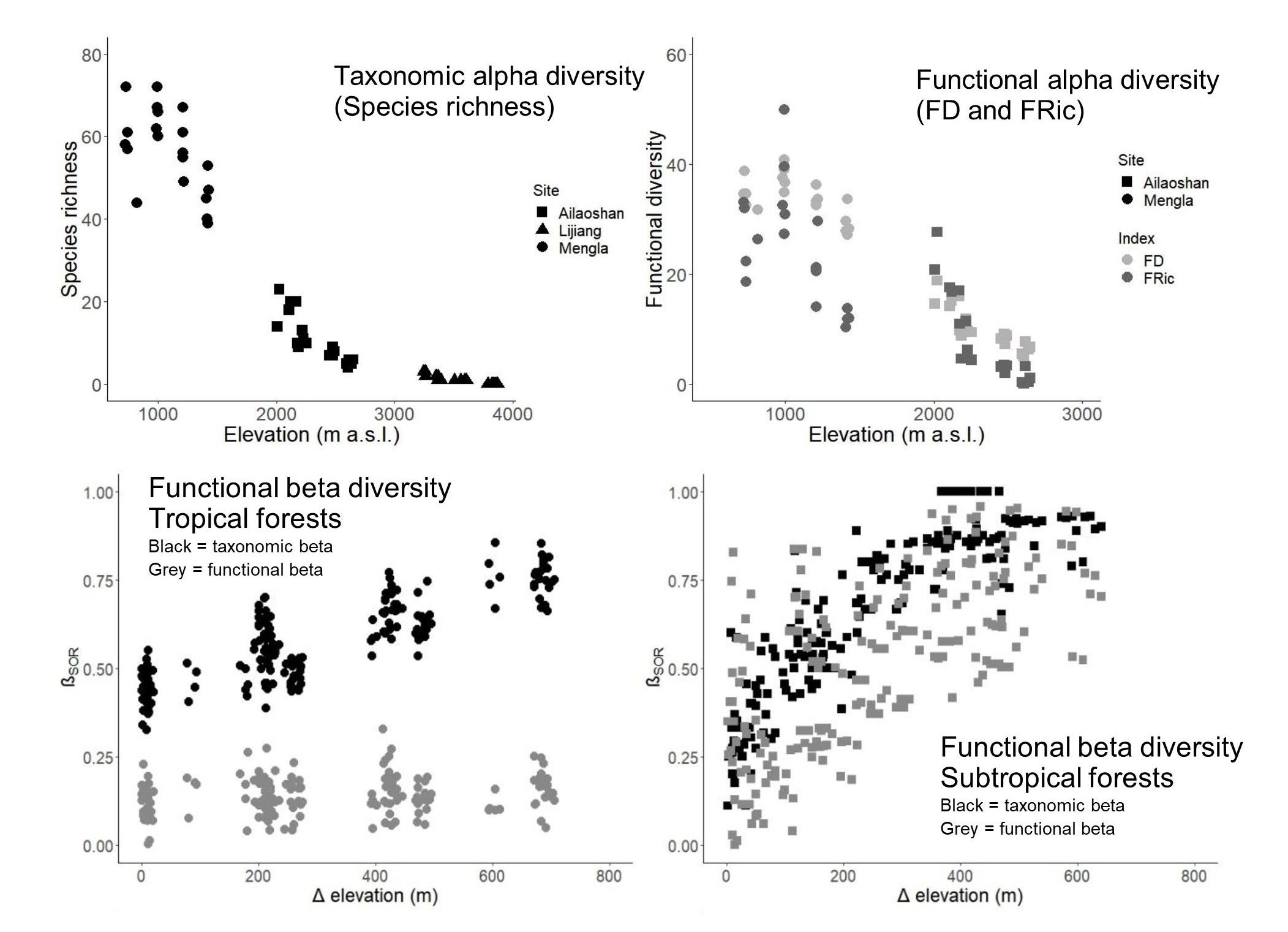
Figure 4. Alyssa Fontanilla showed that ant taxonomic beta diversity (i.e., species turnover) increase with increase elevational distances (Δ elevation) between pairs of samples in both tropical and subtropical forests (black points), whereas functional beta (grey points) only increased with elevational distance in subtropical forests. This implies functional adaptations at higher elevations where environmental conditions were unfavourable for thermophilic ant communities. This study was published in Insects (Q1).
In the second part of her study, she examined whether the body size of ants, geometrid moths, carabid beetles and ichneumonid wasps changed with increasing elevation. The results suggested that no general rule can be designated to describe elevational body size variation for all insects. Analysis has been completed and the first draft of manuscript will be finalized by mid-2020. We aim to publish this paper in Global Ecology and Biogeography (Top 10) or Journal of Biogeography (Q1). She collaborated with taxonomists from various domestic institutions including Institute of Zoology (Drs Hongxiang Han for geometrid moths and Hongbin Liang for carabid beetles), Southwest Foresty University (Professor Zhenghui Xu for ants) and Sun Yat-Sen Univeristy (Dr Alexey Reshchikov for ichneumonid wasps).
(vii) Tri-trophic interactions of predators, arthropod herbivores and plant herbivory in the canopy and understorey of a tropical forest
YuanYuan Quan (MSc candidate, graduated in 2019) used the canopy crane in tropical Mengla to investigate the relative importance of predators on cascading effects through herbivores to herbivory in the forest canopy and understory. This is a collaborative work with Dr Katerina Sam from Czech Academy of Sciences who is extending this study to a global scale. To investigate the relative importance of predator groups, she conducted a manipulative field experiment to exclude three groups of predators—ants, birds and bats, that are considered as important predators in forest systems. To this end, she put nets on tree foliage at day or night to exclude bird and bats, respectively.
Sticky glue was used to stop ants crawling to the foliage (Figure 5).
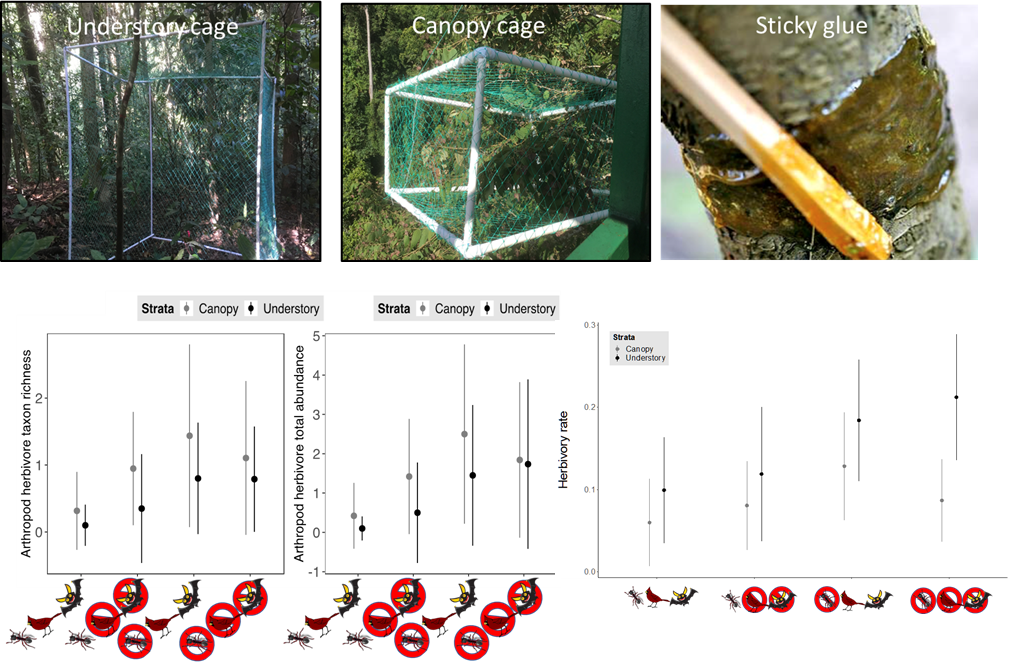
Figure 5. Pictures showing the experimental manipulations of predators (caging to exclude insectivorous birds and bats, and application of sticky glue to exclude crawling insects, including ants), and preliminary results showing the influence of predator guilds on herbivory and herbivore richness and abundance. Red crossed-circles indicated the experimental removal of certain predator guilds. The results showed that ants drove by far the strongest influence, reducing herbivore diversity and overall herbivory in a monsoonal tropical forest of Xishuangbanna where we will conduct proposed project. The pictures and data from Quan, Sam and Nakamura (under review).
The results showed that herbivory and predation were greater in the understorey than canopy, but arthropod abundance and diversity were greater in the canopy than understorey. The manipulative field experiment showed that ants were the most important predators followed by birds and bats (Figure 5). Their cascading influence was most prominent in the understorey. The results have been finalized and she is currently working on the manuscript to be submitted to Oikos or Oecologia by the end of June 2020.
(viii) Drivers of community assembly across vertical forest strata: using container habitats as a model
Lifang Deng (MSc candidate) investigate assembly rules in the forest canopy and understorey, using aquatic container habitat as a model system in the tropical forest of Xishuangbanna. Forest canopy represent climatically harsh environments with high wind velocity, solar radiation, temperature and temperature fluctuations. This is expected to present unstable habitat conditions in which environmental filtering would become a main driver of assembly formation. In contrast, forest understorey is well buffered by the canopy foliage, which may provide more stable habitation conditions. This would result in stochastic processes and competition to be primary drivers of community formation. Deng used artificial habitat containers (plastic container with distilled water) to investigate the relative importance of stochastic and deterministic factors (environmental filtering and competition) in the forest canopy and understorey strata, using the canopy crane established in the tropical Mengla (Figure 6). She set artificial containers in dry (February to May 2019) and wet season (June to August 2019). She utilizes the eDNA metabarcoding technique to analyze water from the containers. This will identify species that are false absence (ever lived in the containers but not present when the containers are retrieved). The data will provide not only aquatic community diversity but phylogenetic structures which enables her to assess the driving factors of the community assembly (stochastic, environmental filtering and competition). Her study is relevant to fundamental questions of ecology and will be published in high impact factor journals.
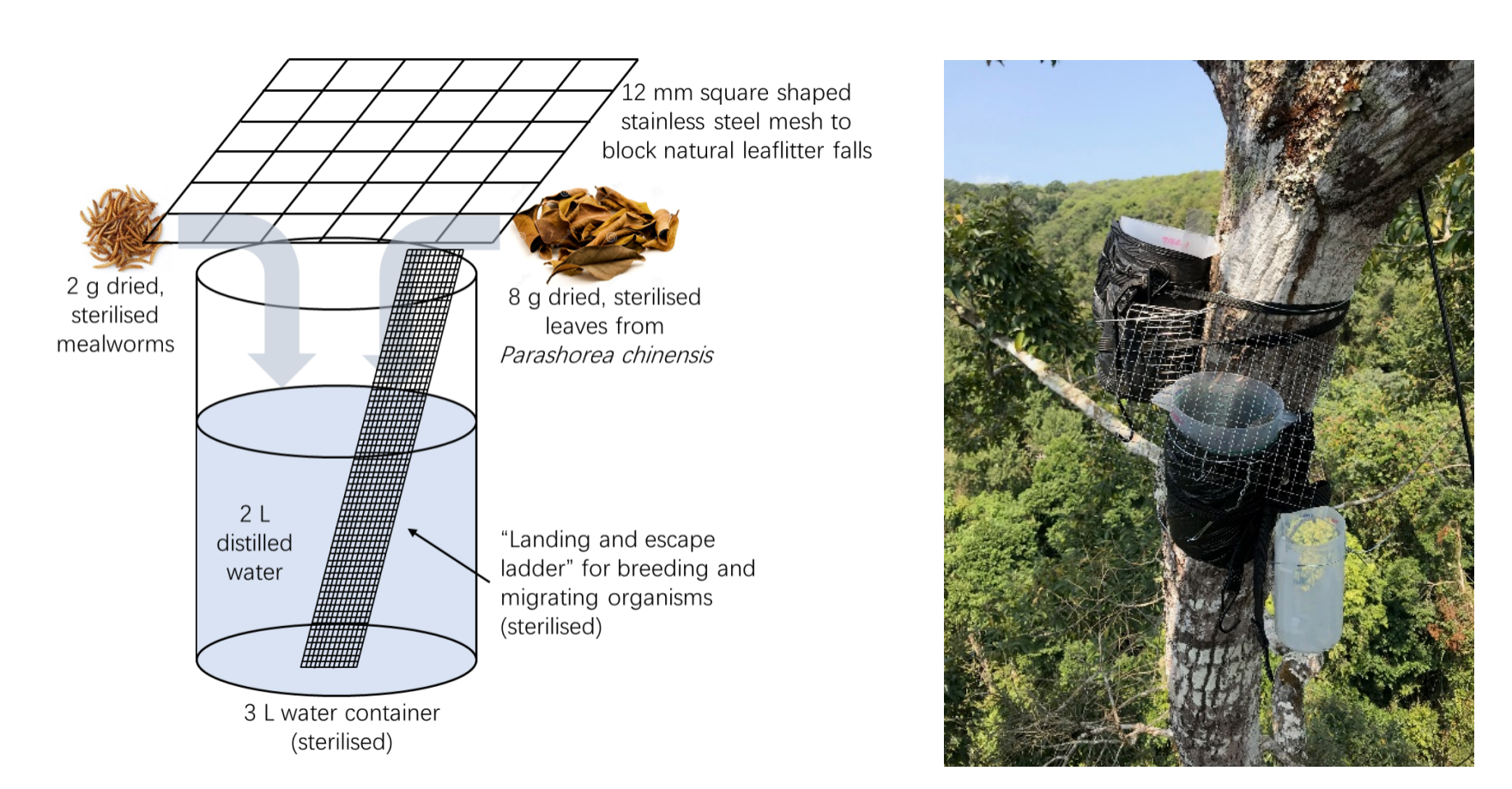
Figure 6. Schematic diagram of the design of the artificial aquatic habitat container (left) and a picture of the containers set in the canopy strata at Bubeng canopy crane site.
(ix) Competitive interactions of arboreal and ground ants in rainforests and rubber plantations
Communities of arboreal ants are often shaped by competition, generating “mosaics” of various dominant ant species among trees. These arboreal ants are observed to forage on the ground which may extend their competitive influence on ground ants. Mizuno is investigating the influence of canopy ants on ground ants by experimental approach by preventing canopy ants from accessing to the ground by applying tangle-foot on tree trunks. Before the experiment, he surveyed ants at all plots by pitfall, bait traps, and litter collecting. After the survey he applied tangle-foot on all tree trunks at a half of the all plots (remaining half plots are control). After the experiment over 6 months, he will collect ants again in the same way as the first survey and compare ant species richness, species composition, and functional composition between before and after exclusion of canopy ants.
(x) Assessing the ecological impacts of artificial lights in primary, secondary and monocultural forests
Members of Forest Canopy Ecology Group and Forest Ecology Group are jointly investigating the ecological impacts of artificial lights on the diversity and ecosystem functioning of forest community. We set up a LED light at five sites in each primary, secondary and monocultural (rubber plantation) forests for over half a year since November 2019. We are measuring diversity and ecological functioning involving invertebrates and plants at the light source, 10 m and 50 m away from the light source to investigate the spatial extent of light disturbance (Figure 7). We will investigate (1) arboreal and ground ant communities (Mizuno), (2) flying insect diversity (Yang), (3) soil micro- and meso-invertebrate communities (Xu, Forest Ecology Group), (4) seedling survival and growth (Song, Forest Ecology Group), (5) litter (tea bags) decomposition (Dossa), (6) soil respiration (Dossa) and (7) predation before and after setting the lights (Mizuno, Nakamura). The lights will continue to run for at least one year. We attempt of investigate as many diversity and ecosystem functioning that are likely to be influenced by artificial light. This kind of manipulative experiment has never been conducted in forest systems and we expect to publish the results in very high-impact journals.
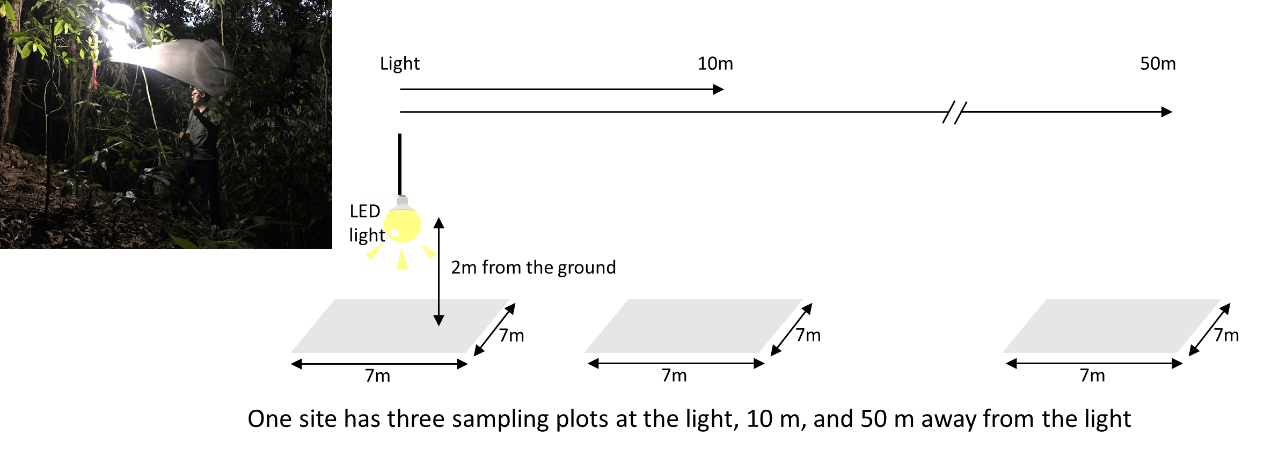
Figure 7. Schematic diagram showing the location of LED light source and sampling quadrats at the light (0 m), 10 and 50 m away from the light. Inset shows the picture of Yang sampling flying insects at the light quadrat in one of the primary forest sites.
(xi) Organic matter decomposition in forests across different spatial scales
Dossa has joined this group in September 2018 and has been working on (1) phylogenetic roles in wood decomposition, (2) decomposition of lianas, and (3) drivers of dead-wood inhabiting communities and their effect on wood decomposition across Asia. Through these projects, Dr Dossa is collaborating with researchers from internationally recognized leading researchers in his field. For instance, Professor Hans C. Cornelissen (http://www.xtbg.ac.cn/xwzx/zhxw/201904/t20190408_5271439.html) already visited this research group and exchanged ideas on the project about lianas and wood decomposition.
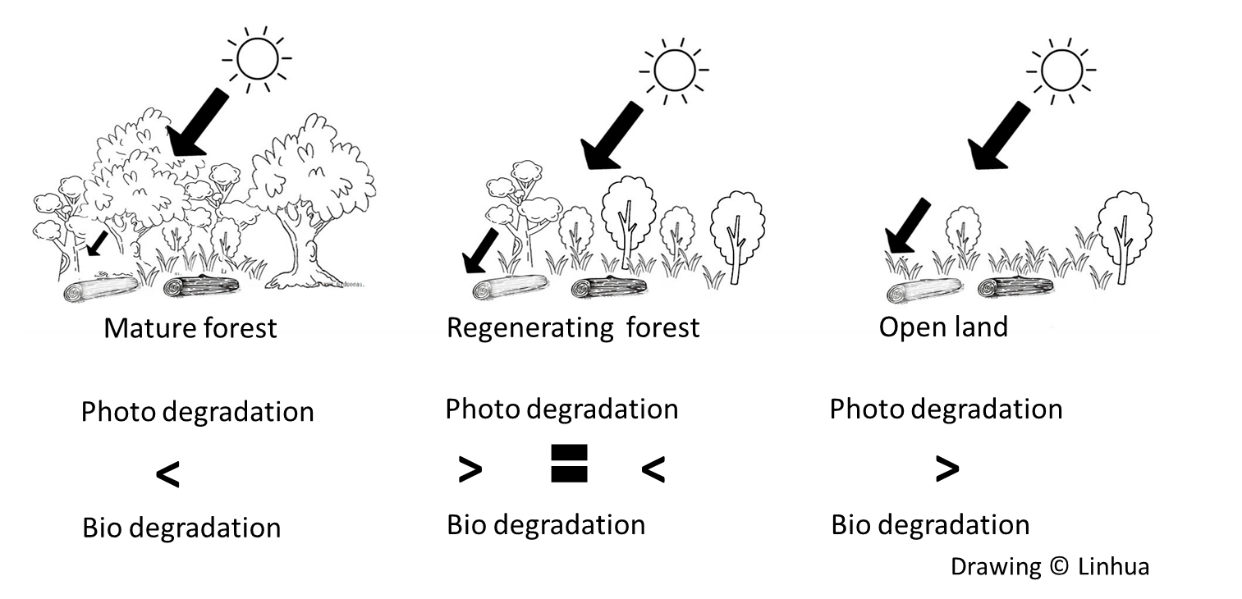
(xii) Statistical modeling on metabolic and structural leaf mass
Katabuchi focuses on using functional traits and statistical models to better understand community dynamics and diversity. He is working on developing a new modeling framework to quantify and understand leaf functional diversity. He is planning to finish a manuscript for international journals on this topic during his work in XTBG.
(xiii) Flowering phenology, floral traits, and plant-pollinator interactions in lianas: a comparison with trees
Ling compares flowering phenology, floral traits and plant-pollinator interactions between co-occurring lianas and trees. Variation in phenological patterns between these two growth forms could be important for resource availability throughout seasons for pollinators, and thus explains species co-existence within a community. As lianas and adult trees generally flower in the canopy, he utilizes the canopy crane at Mengla to regularly visit the forest canopy to observe flowering phenology and examine floral morphology and pollen and flower density, and observe pollinator visitation. He will complete sampling by the end of 2019 and compile data for publication. He is currently analyzing data and writing up the relevant manuscripts of which the first manuscript submission is planned for the second half of 2020.
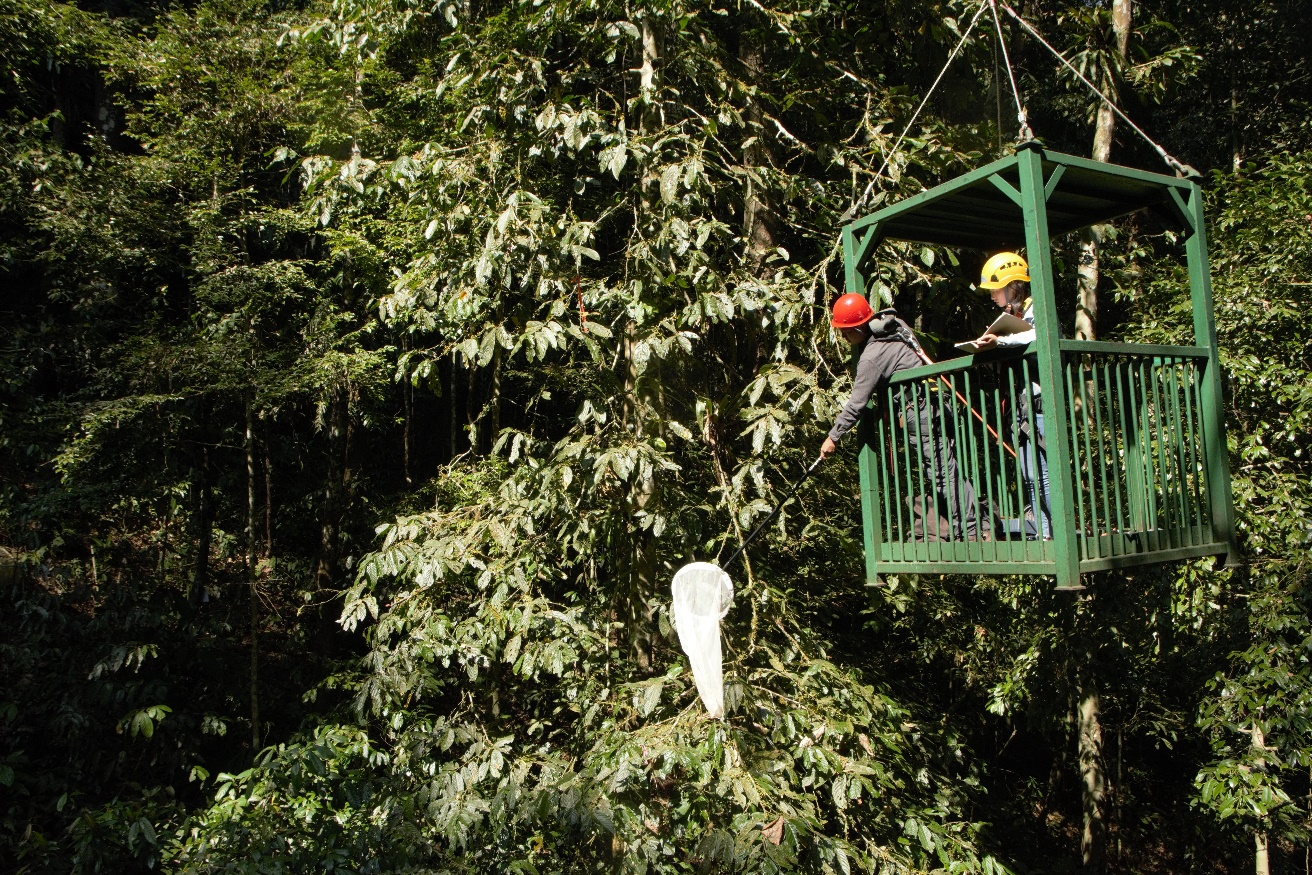
Other projects
The above projects are not comprehensive list of our on-going research. Other projects include: (1) Investigation of factors shaping arboreal ant communities in rubber plantations and rainforests (Kongnoo and Nakamura), (2) Arboreal dung beetles and their diversity in Ailaoshan areas (Nimalrathna and Nakamura), (3) the protective roles of snail-excretion masquerading by saw fly larvae (Mizuno and Nakamura), (4) Moth diversity patterns along elevation gradients within fragmented landscapes (Alcantara and Nakamura), (5) Canopy and understorey insect beta diversity across latitudes and elevations of South East Asian rainforests (Nakamura and Punthwat), and (6) The perception and awareness of butterfly diversity and conservation of local Dai ethnic minority in Southwest China (Yang and Nakamura). We will continue to work on these projects and publish our results in SCI listed international journals.
Copyright 2002-2022 中国科学院西双版纳热带植物园【滇ICP备13004273号-1】




